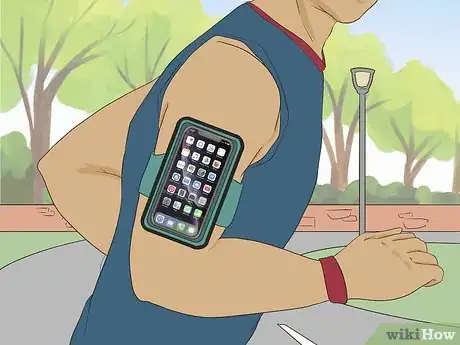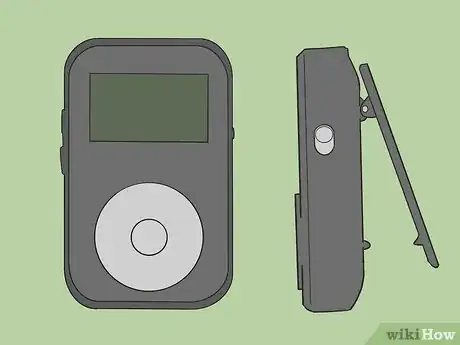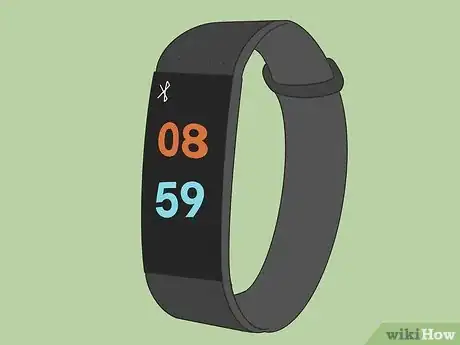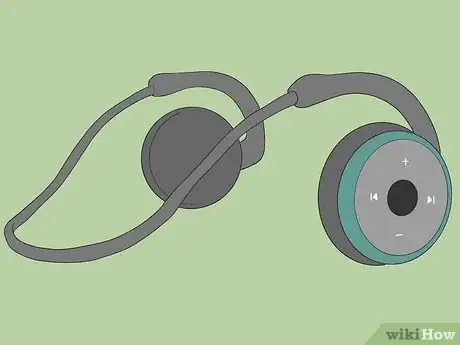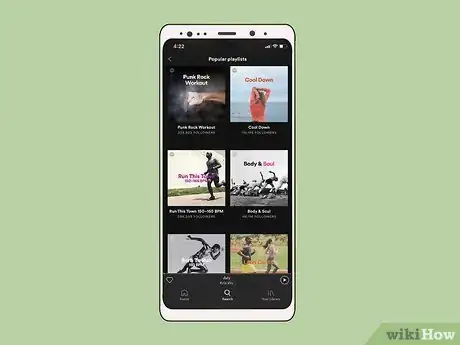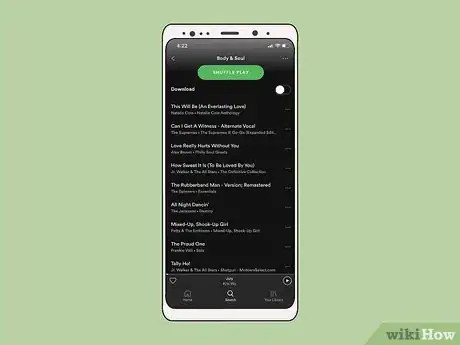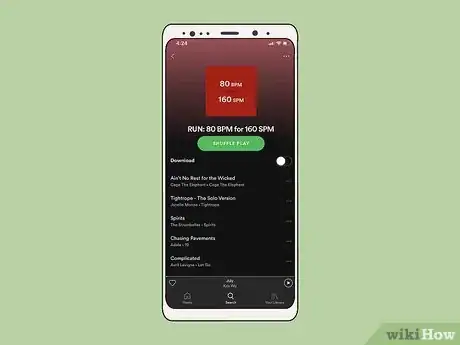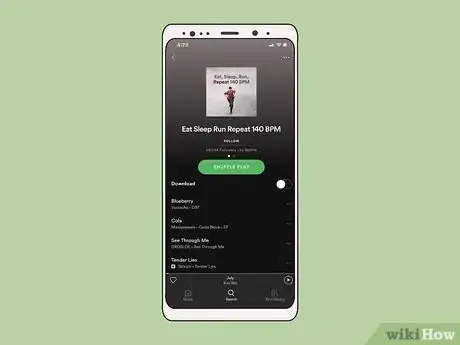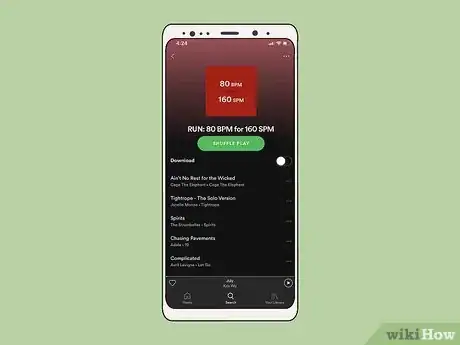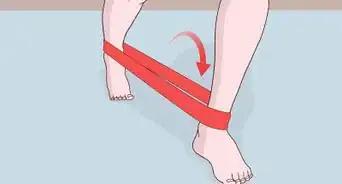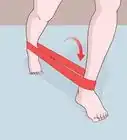This article was co-authored by Francisco Gomez and by wikiHow staff writer, Hunter Rising. Francisco Gomez is the Head Coach at the FIT Potato Gym, a training gym established in 2001 in the San Francisco Bay Area. Francisco is a former competitive runner who helps endurance athletes train for major marathons like the Boston Marathon. Francisco specializes in Injury Rehab, Flexibility, Marathon Training, and Senior Fitness. He has a B.S. in Nutrition and Exercise Physiology & Running.
There are 11 references cited in this article, which can be found at the bottom of the page.
This article has been viewed 48,774 times.
Running while listening to music can help motivate you to boost your endurance and travel a greater distance during your workout. Start by looking for a music device, like your phone or an MP3 player, so you can take your music on the go. Choose headphones that are comfortable to wear, but are made to use for running so they don’t get damaged. Once you have your gear selected, choose a playlist of songs to match your pace so you can run to the beat!
Steps
Finding a Music Player
-
1Carry your phone in an armband so it doesn’t fall or drop. Search online or at a sporting goods store for an armband that fits your style of phone and is sweatproof. Loop the armband around either of your upper arms, making sure the slot for your phone is face-up, and secure it in place with the straps. Slide your phone into the armband when you’re ready to go for your run, and select your preferred music app to get started.[1]
- Many phone armbands have holes or slots in the bottom where you can plug in headphones.
- If you don’t have an armband, you can also hold the phone in your hands, but it may be more likely to slip and fall during your run.
- If you don’t like using armbands or holding your phone, you may use a running belt to hold your belongings.
-
2Find an MP3 player that clips onto your clothes for a lightweight alternative. Look online or at fitness stores to find an MP3 player that has a clip on the back so you can attach it to your shirt or waistband while you’re running. Check the storage capacity and the battery life so you know how many songs it can hold and how long you can use it between charges. Once you select your player, upload your songs onto it so it’s ready to use while you’re running.[2]
- Some MP3 players may not let you select specific songs and will only play your music on shuffle.
- You may be able to find MP3 players made specifically for running and exercise at sporting goods stores.
Tip: Check if the MP3 player is compatible with the type of headphones you use. Some older MP3 models may not support wireless or Bluetooth.
Advertisement -
3Load music onto a smartwatch to avoid carrying any devices. Smartwatches have a limited amount of memory, but they can usually store enough songs to listen to during your run. Plug your watch into your computer or sync the music with your phone so you can listen to it offline. When you go for your run, connect wireless headphones directly to the watch and start running.[3]
- If you aren’t able to directly load songs onto your smartwatch, then you still need to bring your phone with you so it can connect.
- Many smartwatches also track your heart rate and activity levels so you know how you did during your run.
-
4Use a radio headset if you want to listen to AM or FM stations. Radio headsets allow you to tune into any AM or FM radio station in your area so don’t need any additional devices. Search online or at fitness stores for headsets or earbuds that let you tune into the radio and try a few pairs on if you’re able. Choose a fit that’s comfortable on your ears so you don’t ache or hurt after using them.[4]
- You cannot choose specific songs using a radio headset.
Picking Your Headphones
-
1Choose lightweight athletic headphones so you can still hear your surroundings. While you can use any pair of earbuds or headphones while you run, they may be bulky and block out too much noise so you’re unaware of your surroundings. Check fitness or electronics stores for their selection of athletic headphones to see your options. Try a few pairs on if you’re able to so you can see how comfortable they fit in your ears. Make sure the headphones you look at aren’t bulky and don’t feel heavy on your head, or else they’ll be uncomfortable to run in.[5]
- Heavy or bulky headphones may slip off easier or affect your running performance.
Warning: Never turn the volume all the way up while you’re running or else you won’t be able to hear traffic or other people around you.
-
2Look for waterproof headphones so they aren’t damaged by sweat. Headphones can get damaged or slip out of your ears if too much sweat accumulates on them. Check the label or packaging to confirm the headphones you purchase are waterproof or sweat-resistant. That way, you can run in any weather without them breaking or falling out.[6]
- Most headphones and earbuds that are labeled “athletic” or “for running” are already water-resistant.
- Waterproof headphones can be fully submerged underwater without damage, while water-resistant means it can be sprayed with water without affecting their performance.[7]
-
3Tuck wired headphones under your shirt so it doesn’t get tangled. If you plan on using headphones that connect to your device with a wire, run the cord down under your shirt so it’s out of the way. Pull the end of the cord out from the bottom of your shirt if your phone is on your waist or in a pocket, or pull it out from your sleeve if you’re using an armband. Make sure the cord doesn’t flap around or catch on anything or else you may accidentally pull the headphones off your ears.[8]
- Don’t pull the cord too tight, or else the headphones will pop off of your ears if you make sudden movements or stretch the cord more.
-
4Pick Bluetooth headphones if you don’t want to deal with wires. Wireless headphones usually connect to your device via Bluetooth, so make sure you have it turned on for your device. Pair your device with your headphones so they start working and play your music without any cords. Make sure the headphones are secure in your ears so they don’t fall out while you’re running.[9]
- If you’re worried about your headphones falling off, find a pair that has a cord that loops behind your neck to secure them in place.
-
5Try hook earbuds for the most secure fit. Hook earbuds have loops on top that go behind your ears to keep the headphones from falling out. The earbuds may have different hooks so you can choose what size is the most comfortable. Once you put the earbuds in, try shaking your head around to see if they come loose or if they stay in place.[10]
- If the earbuds come loose while they’re hooked to your ear, try using the next smallest size for a tighter grip.
Choosing the Songs
-
1Pick a genre of music you enjoy to stay motivated during your run. You can pick any style of music that you like while you’re running as long as it maintains a steady beat. Either pick 1 genre for your entire run so you can stay in the zone and focused, or choose a number of different songs if you want your playlist to have some variety. Pick enough songs to fill the amount of time that you plan on running so you don’t run out of music.
- For example, you may listen to electronic or rock music while you run so you feel more energized while you run.
-
2Make a playlist of songs to listen to while you’re running.[11] Use your preferred music app and select songs that are high-energy and match your running pace. Select enough songs to fill the amount of time you’re running so you don’t run out of music in the middle of your workout. Name your playlist “Running” or something similar so you know what to play while you go on a run.[12]
- You can organize the songs in your playlist to hear them in order, or you can shuffle the music so it’s random every time you listen.
Tip: Many fitness and music apps have premade playlists made for running. Some of them may even be able to detect your pace and automatically recommend songs to match it.
-
3Warm up with songs between 80-90 beats per minute. When you’re first starting your run, ease into your workout with slower songs so you don’t get worn out right away. Look for songs that have 80-90 beats per minute (BPM) to help you start your run gradually and get accustomed to a comfortable pace. Aim to have at least 2-3 songs in this range for your warmup, which should take around 10 minutes.
- For example, the songs “Take On Me” by a-ha and “Wonderwall” by Oasis are both between 80-90 BPM.
- You can look up the BPM of songs online if you don’t already know it.
-
4Run to songs that are between 120-140 BPM for a moderate pace. Once you find a comfortable pace, start listening to faster-paced songs so you can find a steady pace to maintain during your run. Put together a playlist of songs that have at least 120 BPM to help you find a steady and comfortable pace for your run. Add as many songs as you need for the length of your run. As you get comfortable, add more songs that increase the tempo to push yourself harder.[13]
- Many songs, such as “Teenage Dream” by Katy Perry and “Don’t Stop Believin’” by Journey, are around 120 BPM.
- Don’t use too many songs that change between tempos since it could affect your running speed and efficiency if you’re constantly adjusting.
- Be careful running to faster music since you may develop aches and pains sooner.
-
5Cool down and stretch to songs that have around 80 BPM. When you’re finished with the main part of your run, put on more slow music to help you relax and lower your pace. Aim to have 2-3 songs at a slower tempo for your cool down so you’re able to start relaxing and ease into stretching. When you’re finished with your run completely, stop your music to end your workout.
- Make sure you cool down after each run so you don’t develop aches or cramps.
Warnings
- Stay aware of your surroundings while you’re running with music outside so you stay safe from vehicles and other people.⧼thumbs_response⧽
References
- ↑ https://outdoorfitlab.com/running-belt-vs-armband/
- ↑ https://youtu.be/zHIjfKJwhyU?t=60
- ↑ https://gadgetsandwearables.com/2019/05/07/running-watch-gps-music/
- ↑ https://healthfully.com/230850-the-best-amfm-radio-headphones-for-jogging.html
- ↑ https://runningdenver.com/5-tips-for-choosing-the-best-headphones-for-running/
- ↑ https://runningdenver.com/5-tips-for-choosing-the-best-headphones-for-running/
- ↑ https://www.reviewed.com/headphones/features/what-do-waterproof-and-water-resistant-really-mean
- ↑ https://gearpatrol.com/2017/06/07/the-case-for-cheap-wired-headphones-for-running/
- ↑ https://runningdenver.com/5-tips-for-choosing-the-best-headphones-for-running/
- ↑ https://awwkward.com/best-wireless-headphones-running/
- ↑ Francisco Gomez. Fitness Coach. Expert Interview. 24 October 2019.
- ↑ https://gizmodo.com/the-most-mathematically-perfect-playlist-for-running-u-5906815
- ↑ https://www.runnersneed.com/expert-advice/training/running-and-music-finding-your-bpm.html
